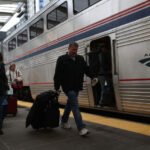Route-Fifty – March 22, 2023 | By Danil C. Vock
On paper, Tennessee looks like the perfect place to expand passenger rail service. It has a fast-growing population, a thriving tourism industry, and several large metropolitan areas both in the state and nearby. But Tennessee has a lot of catching up to do quickly if it wants to join the ranks of states looking to introduce new rail routes with federal infrastructure money.
Only two intercity passenger trains a day make stops in the state of nearly 7 million people: The Amtrak City of New Orleans train stops in Newbern and Memphis, as it travels north and south between Chicago and Louisiana. That leaves a 400-mile stretch between the Mississippi River and the Appalachian Mountains with no passenger rail options.
“If you look at a route map for Amtrak, there is a huge void in Tennessee,” said state Rep. Jason Powell, a Democrat who represents Nashville and who has led efforts in the legislature to explore options for passenger rail expansion.
Powell sees Tennessee as a “pivotal state” for the planned expansion of Amtrak, which will be funded through the 2021 federal infrastructure law and that is approaching a critical deadline next week. Nashville is currently the third-largest city in the country without passenger rail service (behind Las Vegas and Columbus, Ohio), he says, but the Music City eventually could be a new hub for Amtrak given how close it is to other growing cities.
To do so, though, Tennessee would essentially have to create a passenger rail network from scratch.
The last regular Amtrak train to run through Nashville left in 1979. Since then, there have been waves of interest in reinstating service but little action, says Jarod Pearson, the president of the Tennessee Association of Railroad Passengers.
U.S. Sen. Al Gore Sr. tried unsuccessfully to reverse cuts from the Carter administration. Then, advocates rallied behind a futile effort to connect Nashville and Atlanta ahead of the 1996 Olympics. Amtrak briefly ran a route between Chicago and Louisville, Kentucky, in the early 2000s, and the railroad tested a train that went on from Louisville to Nashville. But the concept never took hold.
Now, enthusiasm is running high again. Amtrak released a map two years ago of potential service expansions that showed a connection between Nashville and Atlanta that ran through Chattanooga. The railroad has also tried to drum up interest among Tennessee lawmakers for a connection between Memphis and Nashville. Meanwhile, Virginia plans to expand its passenger rail service to Bristol, on the border with northern Tennessee.
Those developments come as the Biden administration is deciding how to spend $66 billion available for passenger rail improvements from the Infrastructure Investment and Jobs Act. The first big step in that process is deciding which rail corridors to focus funding on. States have until next week to tell the Federal Railroad Administration (FRA) which routes they want to go ahead with.
“We need all eyes to be on states like us that are growing, because that’s where the passenger rail service is needed,” Pearson said. “It will give us another transportation option for people who live here but also for people who would like to visit.”
Tennessee will miss next week’s federal deadline for new corridors, but state officials hope they can get federal support in later rounds of funding from the five-year infrastructure law.
Howard “Butch” Eley, the commissioner of the Tennessee Department of Transportation, sent a letter to federal officials in December explaining why the state would not apply for a grant through the FRA’s Corridor Identification Program.
The state legislature ordered its research arm to study possibilities for passenger rail expansion, but the evaluation by the Tennessee Advisory Commission on Intergovernmental Relations (TACIR) would not be completed in time for the March deadline, Eley explained.
“While we are not in a position to submit a specific corridor, … we did want to submit a letter to your agency to let you know that there is great interest in Tennessee when it comes to passenger rail,” Eley wrote.
Charting a New Course
The state study is looking at eight possible routes:
- Nashville to Chattanooga
- Nashville to Memphis
- Chattanooga to Knoxville
- Knoxville to Bristol, Tennessee
- Chattanooga to Atlanta
- Memphis to Carbondale, Illinois
- Bristol, Tennessee, to Roanoke, Virginia
- Nashville to Louisville
Dan Pallme, the head of the Tennessee Department of Transportation’s freight and logistics division, said the legislature’s study could help head off regional rivalries if it finds some routes work better than others. He expects the report to come out in June or July. After that, the state transportation department will look over the study and will likely do its own evaluation before applying for the federal funding next year.
Pallme said Tennessee will not lose much in missing next week’s deadline. The initial federal grants, he said, are for $500,000 to study the potential corridors, which the state is essentially doing now. The grants require substantial detail for the application, but the next step is for more in-depth analyses. “The reality is, you still have to do extensive research to [see] how the route is going to go and how it’s going to affect freight on that line,” he said.
Many people in Tennessee want to coordinate with Virginia to extend its planned service to Bristol, Virginia, across the border to places such as Knoxville and Chattanooga. Using the Virginia connection would give those Tennessee passengers a way to get into Washington, D.C., and transfer to the Northeast Corridor line.
But Virginia doesn’t plan on starting service to Bristol for several years, Pallme pointed out. Without connections to the bigger network, improvements in Tennessee would have a limited effect.
“You really have to study it and study it and study it some more, because if we had great train service from Bristol, Tennessee, to Chattanooga overnight, tonight, that’s great, but until it connects to the Northeast Corridor, you’re not going to have that ridership,” he said.
But Pearson, the passenger rail advocate, said too many studies have bogged Tennessee down. He and Powell, the state legislator, also said that to clear the way for passenger rail the state should consider creating a governmental agency that specifically focuses on rail service for passengers, instead of it being part of the same department that oversees freight operations.
In terms of routes, Pearson suggested that the state initially focus on expanding existing Amtrak service into Tennessee, which is how Virginia and North Carolina built up their rail ridership.
“We need to not go and create something brand new from the ground up,” he said. “What we need to do is revisit older proposals or find existing ideas, because that’s where we’re more likely to get tangible results and a lower startup cost.”
Pearson proposed, for example, that Tennessee work with Illinois to extend its state-run trains from Carbondale into Memphis, adding more daily connections for Tennessee passengers. Tennessee could also work with Indiana and Kentucky to revive a route that went from Chicago to Indianapolis, Louisville and onto Nashville. Those trains might even be able to connect to Birmingham, Alabama, he said.
On the other hand, efforts to connect Nashville to Atlanta would take longer, because it poses many difficult problems. First of all, Amtrak’s existing Atlanta station is a tiny building four miles north of downtown next to a highway overpass, which is not an ideal place for passengers to disembark. Second, the rail route between Chattanooga and Nashville is particularly congested already, because two freight railroads share the track along the Tennessee River.
Likewise, the most direct route between Memphis and Nashville has long been abandoned, and in the eastern part of the state, parts of an old rail connection between Nashville and Knoxville have been lost as well.
“The problem for Tennessee,” Pearson said, “is that the longer we wait to take action, the harder it is to start the service and the more expensive it is.”







